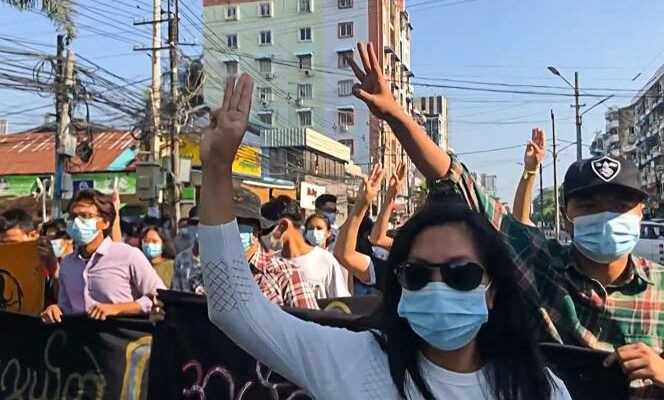Thousands of people demonstrated on Sunday May 2 against the junta, some hoping for a “Revolutionary spring” in Burma, where a powerful rebel faction in the east of the country called on other insurgent groups to unite against the military.
Since February, despite a bloody repression, almost daily demonstrations have shaken the country, a vast campaign of civil disobedience – with thousands of striking workers – paralyzes entire sectors of the economy and opponents, gone underground, have formed a government of resistance.
Bloody repression
Rallies formed again early Sunday morning in Yangon, with radical protesters calling for the advent of a “Revolutionary spring”. Young people notably gathered at a crossroads in the economic capital before quickly marching through the streets. They quickly dispersed to avoid confrontation with the security forces. “Our path leads to democracy! “ they chanted, with three fingers raised in resistance. Explosions also sounded in the morning in several areas of Yangon. The explosions have increased in recent times in the former capital.
Hundreds of people also marched in the Mandalay region (center) with monks in saffron robes leading the procession, carrying the flag of the National League for Democracy (NLD), the party of ex-leader Aung San. Suu Kyi. The 1991 Nobel Peace Prize laureate has not been seen in public since her arrest in the putsch that toppled her on 1er February. She has since been placed under house arrest. In Shan State (northeast), security forces intervened against demonstrators in the town of Hsipaw, killing at least one. “He was shot in the head and died instantly”, testified a protester, who said he concealed the body of his friend to prevent the security forces from taking him. “They are asking for the body but we will not give it. His funeral will take place today ”, he explained to Agence France-Presse (AFP).
In Kachin State (north), security forces opened fire on demonstrators. A 33-year-old man was shot in the head, according to a protester who said many were injured. “They all had to be treated in hideouts. They could not go to the hospital, otherwise they would have been arrested there ”, explained another protester.
Nearly 760 civilians have been shot by security forces in the past three months and some 3,500 are in detention, according to a local NGO, the Association for the Assistance of Political Prisoners (AAPP). The junta, which affirms that the AAPP is an illegal organization, assures for its part that 258 demonstrators died, as well as 17 police officers and 7 soldiers.
More than 2,000 refugees in Thailand
In several border regions in the North and East, the protest brought out of the shadows several rebellions carried by ethnic minorities in confrontation with the army, some of which shelter in the territories they control opponents who fled the repression of the junta.
In the east of the country, where clashes between the army and the Karen National Union (KNU) have displaced more than 30,000, according to the UN, junta airstrikes targeted on Friday night in Saturday an area close to the Thai border, causing a new wave of refugees. More than 2,300 Burmese have crossed the river that marks the border to seek refuge in Thailand.
On Sunday, the Karen National Union (KNU) called on other insurgent factions to unify their ranks against the junta. “Never has there been such an opportunity in more than seventy years of revolution. Take advantage and fight the Burmese military dictatorship », said Lt. Gen. Baw Kyaw Heh. His message is addressed to the other rebel groups in Karen State, the Karen Buddhist Democratic Army (DBKA) and the KNU / KNLA Peace Council, born out of a split from the KNU – two groups that have remained silent since the coup. State of 1er February.
